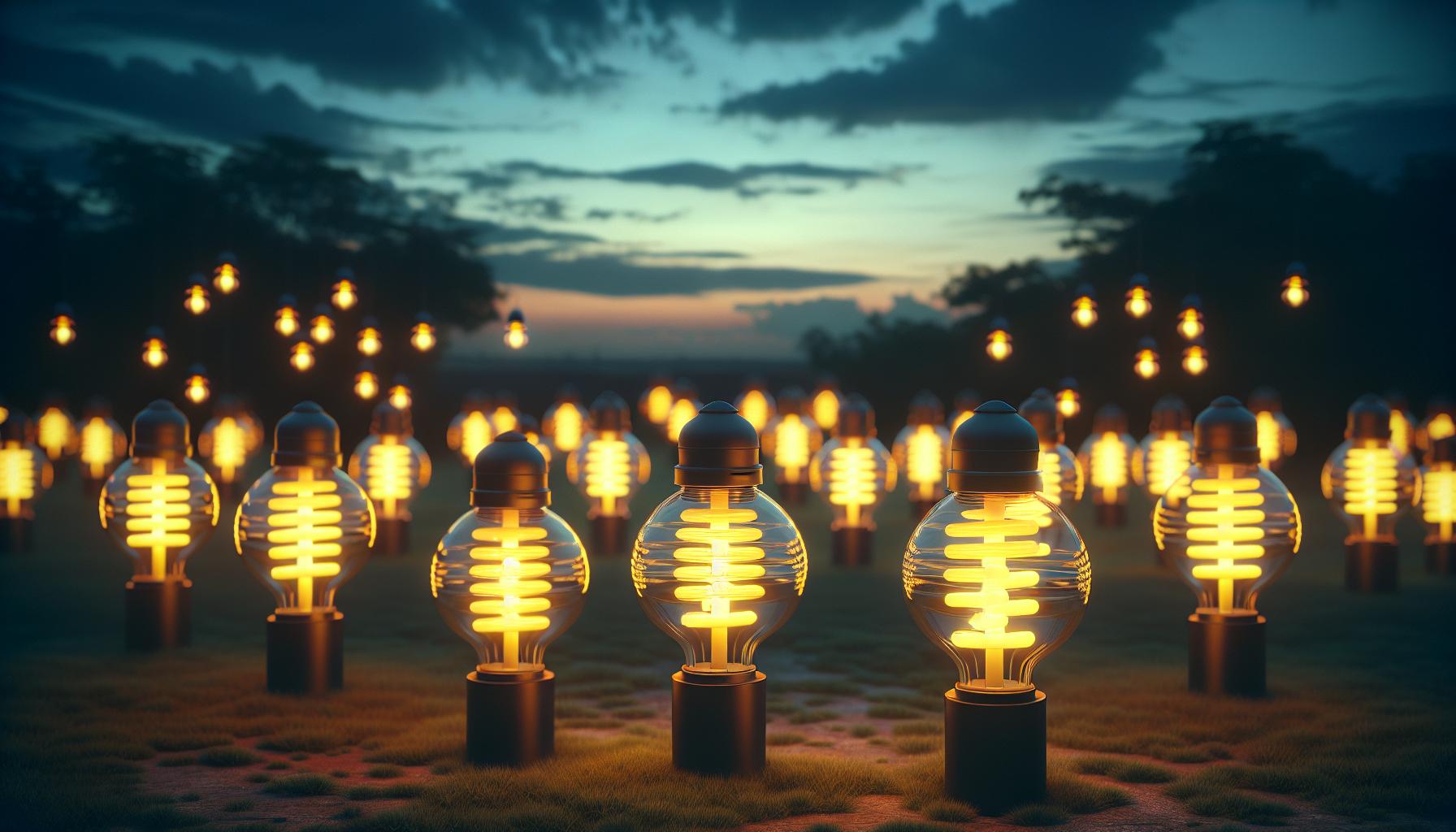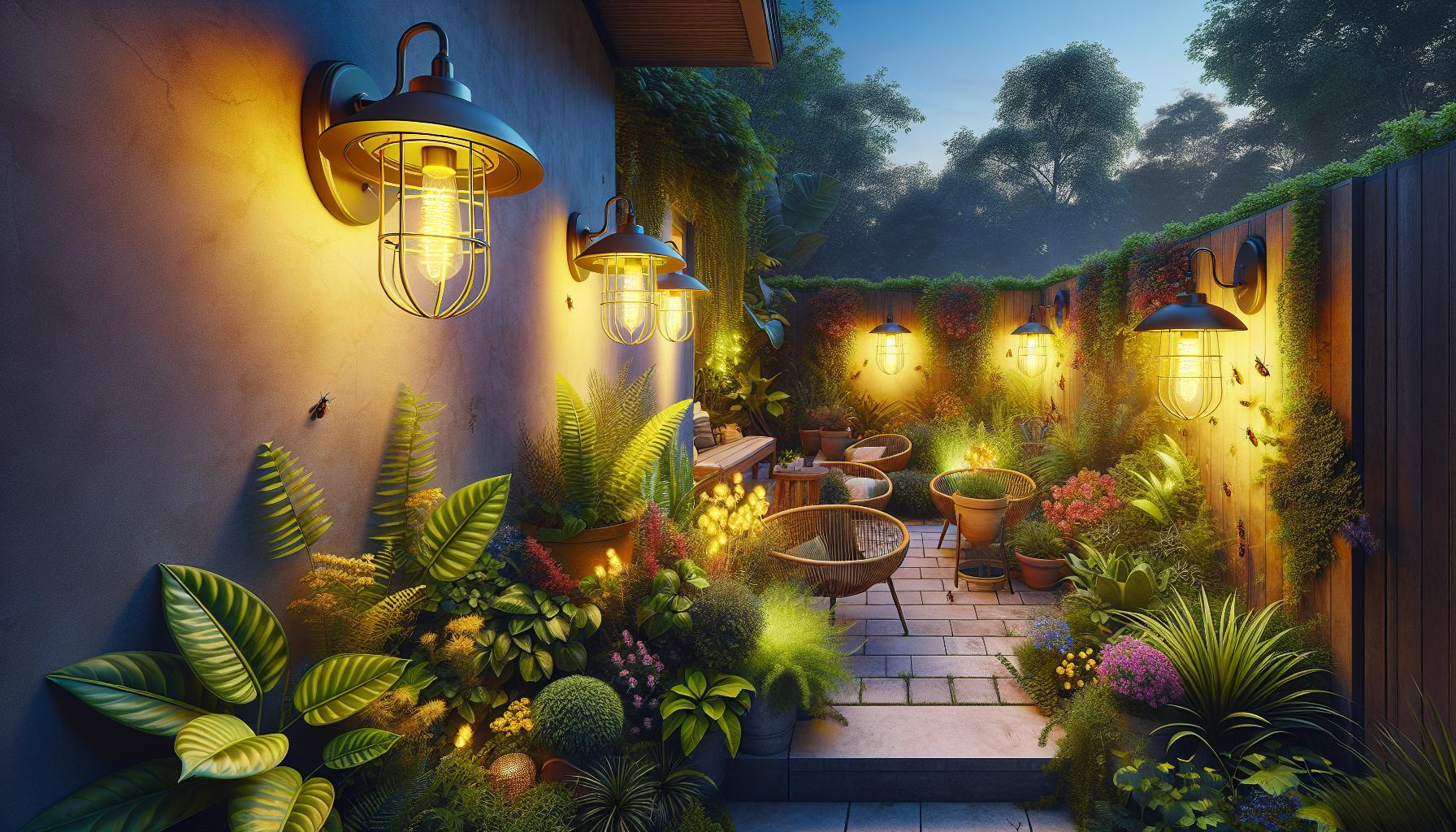Ever found yourself swatting away at pesky bugs while trying to enjoy a warm summer evening on your porch? You’re not alone. The secret to a bug-free zone might just be the color of your light bulbs.
It turns out, bugs aren’t just annoying; they’re also picky about their light sources. So, if you’re looking to reclaim your outdoor space, you’ve got to get strategic with your lighting choices.
The Importance of Choosing the Right Light Bulb
When you’re equipping your outdoor spaces, don’t underestimate the influence lighting can have on your comfort. It’s not just about setting the right mood – it’s a matter of function, especially when it comes to keeping bugs at bay. The right light bulb is a subtle yet effective defense against these buzzing intruders.
As a light bulb aficionado with a love for DIY projects, you’ll know that the color temperature measured in Kelvin (K) is a key factor. Bulbs with a warmer color temperature are less appealing to bugs. These typically range from 2700K to 3000K and cast a soft, yellowish hue that’s cozy and welcoming for humans, yet less visible to bugs.
Selecting the perfect wattage is also crucial. A lower wattage light emits less heat and brightness, which makes your outdoor area less of a bug magnet. Moreover, with today’s technology, LED bulbs offer a double benefit: they produce less heat and come in varied color temperatures suitable for bug-free outdoor lighting.
Keep in mind the position of the lights. Mount them away from doors and gathering areas. By doing so, any attracted insects will congregate around the light source and not where you spend most of your time. Now, let’s not forget about energy efficiency and longevity – another reason to consider LEDs. They use less energy and last significantly longer than traditional bulbs; this means fewer trips to the store and more time enjoying your bug-reduced al fresco living.
To loop it all back, your choice in light bulbs is more nuanced than aesthetic appeal – it’s a strategic decision that impacts everything from your power bills to how much you scratch those pesky bug bites. Light up your life and deter those unwelcome guests with the wisdom of smart lighting choices. Your evenings outdoors will thank you.
Understanding Insects’ Attraction to Light
You’ve probably noticed how moths and other insects swarm around outdoor lights during the evening. But why does this happen? It’s not just your light’s brightness that catches their eye; there’s more to the story.
Insects are primarily attracted to specific wavelengths of light. They’ve evolved to navigate by natural light sources like the moon and stars, which emit a broad spectrum of light. When you introduce artificial light into the mix, you’re essentially throwing off their internal GPS. Certain wavelengths—like those emitted by many outdoor and street lights—can confuse and lure insects.
Research shows that insects are less interested in light at the redder end of the spectrum. This is great news for your outdoor lighting game! By choosing bulbs that emit light with a warmer color temperature, you stand a better chance at making your evenings more pleasant, and less buggy.
Let’s delve into the science of it. UV light and blue light attract insects the most. This is because many of the flowers and plants they pollinate reflect UV light, making these wavelengths a beacon for bugs. Conversely, bulbs that emit yellow, orange, or red light are far less attractive to our six-legged friends.
Here’s a pro tip: when shopping for bug-resistant lighting, look for bulbs labeled as “bug lights” or those that mention a color temperature of 2200K to 3000K, which is often indicated on the packaging.
Moreover, the brightness of a bulb, measured in lumens, plays a role in insect attraction. Brighter is not always better, especially when you’re trying to keep a low profile in the buggy world. Go for bulbs with a lower lumen output to minimize your outdoor space’s allure to insects.
« Why Are Light Bulbs So Important? Unveiling Their Role in Your Health & Economy
How to Dull a Light Bulb: Soften Glare for Perfect Ambiance »
Remember, it’s not just about choosing any light bulb; it’s about selecting the right one that matches up with insect behavior and preferences. By understanding what draws them in, you can turn the tables and implement lighting that’s welcoming to friends and family, but a no-fly zone for pests.
The Role of Light Color in Bug Attraction
As you’ve become an aficionado of home DIY lighting projects, you probably know that not all lights are created equal when it comes to bug attraction. Let’s dive into why some colors of light are practically a beacon for bugs while others keep them at bay.
Bugs have eyes that are sensitive to certain wavelengths of light—primarily, they’re drawn to ultraviolet (UV) and blue light. That’s the kind of light that you’ll find in abundance with cooler-colored bulbs, the ones that have a higher color temperature, which is measured in Kelvin (K). For instance, bulbs rated around 5000K to 6500K emit a color akin to daylight, which, unfortunately for your evening BBQ, is irresistible to most flying insects.
Here’s the kicker, though. Switch to warmer colored bulbs, those with a lower color temperature, and you’ll notice fewer bugs swarming your space. Bulbs within the 2200K to 3000K range give off a cozy, amber hue, which is less visible to bugs. Essentially, you’re making it harder for them to spot your light among other environmental cues.
Moreover, it’s not just about the warmth of the color but also the spectrum. LED bulbs, for instance, are available in “bug lights” that can produce a yellow spectrum that’s harder for bugs to see. Here’s a pro tip: look for bulbs specifically labeled as bug-repellent, which often means they emit light at wavelengths less attractive to insects.
On top of color temperature, pay attention to the CRI, or Color Rendering Index, of your bulbs. While CRI doesn’t directly impact bug attraction, it affects how color appears under the light—important for your overall outdoor ambiance. Opting for bulbs with a CRI closer to 100 means colors will appear more vivid and natural, letting you create the perfect setting for your evening gatherings without turning them into a bug fest.
Bear in mind, while the right bulb can help reduce bugs, it’s not a silver bullet. You’ll still have to contend with other factors like location and environmental factors that could impact bug attraction. But armed with the right information about light color and temperature, you’re one step closer to a bug-free zone. Remember, it’s all about finding that sweet spot—a bulb that caters to both ambiance and functionality.
Light Bulb Colors that Repel Bugs
Welcome back to our shining discussion on keeping those pesky bugs at bay. You know the frustration of a bug-filled porch during a summer evening. Let’s illuminate the colors that can transform your outdoor space into a less welcoming spot for bugs.
Yellow and orange bulbs are your go-to choices for bug repellent lighting. These warmer tones are near the bottom of the light spectrum that’s visible to bugs, meaning they’re less likely to be drawn to your evening chill-out zone. Specifically, bulbs labeled as bug lights are designed to minimize the blue light waves, reducing the bug banquet in your backyard.
You might be thinking, “But isn’t white light made of all colors?” You’d be right, but that’s practically an invitation for an insect rave. That’s why it’s worth investing in LED bulbs that produce a narrow spectrum of light—ones that emit wavelengths insects aren’t privy to. In addition to their bug-deterrent properties, LEDs are more energy-efficient, so you’re not only fending off the creep-crawlies but also saving on your energy bill.
Here’s a quick rundown on the optimal light color temperatures to keep bugs from turning your outdoor area into their hangout spot:
| Bulb Color | Color Temperature (K) | Visibility to Bugs |
|---|---|---|
| Warm Yellow | 2200 – 3000 | Low |
| Warm Orange | 2000 – 2500 | Very Low |
| Bug Lights | Specific Narrow Range | Minimal |
Beyond the bulb’s color, it’s wise to consider the surrounding environment. Your lighting choices can be supported by landscaping that’s unattractive to bugs or by making sure outdoor lights aren’t placed near doors and windows where bugs are more likely to enter your home. Remember, positioning is just as vital as the lightbulb’s color.
As you dive into your next DIY lighting project, keep in mind the color temperature and spectrum. A well-lit yard that keeps the bugs away isn’t just comfortable—it’s a testament to your savvy home improvement skills. Keep these tips in hand and get ready to enjoy your brighter, bug-resistant outdoor space.
Tips for Using Bug-Repelling Light Bulbs Effectively
You’re in the thick of battling bugs, and you’ve armed yourself with the best color light bulbs to keep those pests at bay. But how do you ensure you’re using these bulbs to their fullest potential? Proper placement and maintenance are key to keeping your outdoor evenings peaceful and bug-free.
Strategic Placement
When it comes to placing your bug-repelling light bulbs, think like a strategist. Avoid positioning these lights directly next to doors or windows where bugs are naturally attracted to enter. Instead, place them further out in your yard or perimeter:
- Use pole lighting or up-lighting for gardens and trees to draw bugs away from your home.
- Light paths or walkways with shielded fixtures to reduce the direct light spread.
- Opt for wall sconces with yellow bulbs around patios and decks.
Leverage Light Fixtures
The type of light fixture you use can make a significant difference. Shielded fixtures direct the light downwards, minimizing the skyward light that attracts flying insects. Go for fixtures that:
- Are fully enclosed to protect the bulb and increase its effectiveness.
- Have a high IP rating for outdoor use to withstand weather conditions.
Regular Cleaning
Light bulbs and fixtures can accumulate dust and debris. Regular cleaning will not only ensure optimal light output but also reduce the likelihood of bugs getting attracted to the heat generated by the bulb. Make a habit of wiping down your outdoor fixtures every month or so with a dry cloth.
Complement with Other Deterrents
Using bug-repelling bulbs is just one part of the equation. Combine these lights with other bug deterrents for a multi-layered defense:
- Install screens on doors and windows.
- Use natural repellents like citronella candles or essential oil diffusers in outdoor seating areas.
- Consider planting bug-repelling plants nearby such as lavender, marigold, or citronella.
Remember, it’s not just about the bulb you choose but also how you integrate it into your environment. With some careful thought and a bit of regular upkeep, you can significantly reduce the pesky intruders and make your evenings under the stars more enjoyable. Keep experimenting with different configurations to see what works best for your space. After all, a well-lit home is both inviting and secure—minus the bugs, of course.
Conclusion
So you’ve got the inside scoop on keeping those pesky bugs at bay with the right light bulbs. Remember, it’s all about how you use them. Get creative with your outdoor lighting to make your evenings more enjoyable and less buggy. And don’t forget, a little upkeep goes a long way—keep those bulbs clean! Pair your lighting with other bug-deterrent tactics for an even more peaceful atmosphere. Now, go ahead and tweak your setup to perfection. You’ve got this!
Frequently Asked Questions
Where should bug-repelling light bulbs be positioned for utmost efficacy?
Bug-repelling light bulbs are most effective when positioned at a distance from areas of activity, such as using pole lights for garden spaces or up-lighting to draw bugs away from the home.
Can the design of the light fixture impact bug attraction?
Yes, shielded light fixtures that minimize upward directed light can help reduce the presence of flying insects attracted by the skyward light.
How often should bug-repelling light bulbs and fixtures be cleaned?
Regular cleaning of light fixtures and bulbs is recommended to prevent the warmth of the bulb from drawing in bugs due to heat accumulation.
What additional methods can complement bug-repelling light bulbs?
Complement bug-repelling bulbs with screens on doors and windows, citronella candles, essential oil diffusers, and planting bug-repelling vegetation.
Is it necessary to stick to one method of bug-repelling in a space?
No, it’s advised to experiment with different deterrents and light configurations to find the best solution for your individual space and bug-repelling needs.





